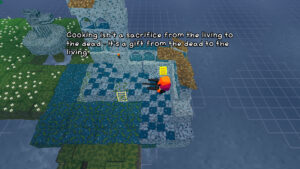IFComp 2020: Babyface
Here we have a mixed-media short story in the Southern Gothic mold, where you investigate creepiness from your family’s past. It’s decently written, and has an intriguing central idea, “Looking at a thing uses it up”, that motivates the creep’s creepy behavior — hiding from sight, wearing masks — and provides a clear metaphor for the value of bringing secrets to light, to defeat darkness and danger with an unflinching gaze.
But it’s barely interactive. There are bits where you choose which of your deceased mother’s old snapshots to examine. So you have some control over the order in which bits of backstory are elaborated on, but no agency beyond that. Instead, it’s mainly using Twine to govern presentation: sound cues, fade-ins, and the like. The sort of gimmickry that I always complain about because it interferes with engagement with and immersion in the text. And of course it has an excess of forward links, often showing only a sentence or two at a time, sometimes even just a sentence fragment, with a solitary link on the last few words to show more. This is a style that the Twine community at large seems to have embraced, but it’s always bothered me. What’s wrong with just putting in a paragraph break?
It’s even innovated new ways to annoy me! In addition to text that fades in after a delay, we now have text that fades out after a delay. It does some clever things with it, fading out all but certain words, as if revealing meanings that were lurking there unobserved all along, like Babyface in his creepy house. But it also has the effect, probably unintended, that once I knew it could happen, I wound up rushing through reading passages from that point onward, just in case they started disappearing before I was finished. I suppose individual passages aren’t all that important in a work that works more from building up a cumulative effect. But that’s what I did nonetheless.
There’s one gag that I quite liked, though: at one point, the text describes a fly bothering the protagonist while it plays an animation of a fly landing on the screen, silhouetted by the monitor’s glow. Somehow, the effect here was that I kind of filtered out the fly’s buzz until I reached the point in the text where it’s mentioned, triggering the shock of recognition.
 Comments(1)
Comments(1)